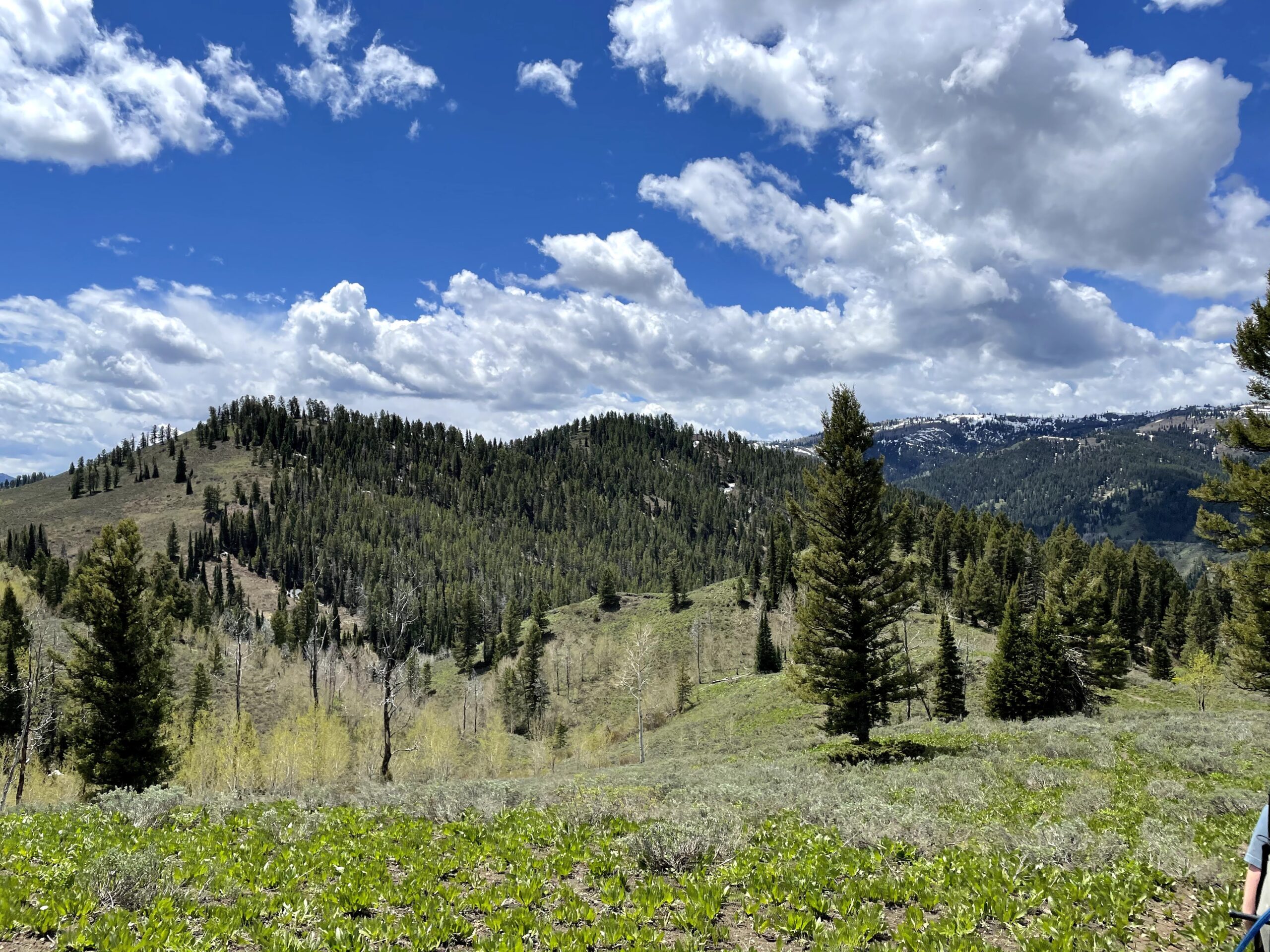It was my first summer working as a technician during fawning season on the Wyoming Range Mule Deer Project, and this hike was special. It was the middle of June, which meant that the last several weeks of my life had been spent thinking about mule deer almost exclusively.
On this day, my hiking partner Kelly and I had two mule deer moms to check out, which is to say that we had two hikes ahead of us, two up-to-three-hour-long searches for newborns waiting for us as the hours passed. It is lucky that deer give birth in the late spring, when the days are getting longer: we needed every bit of daylight each day, often flicking our headlights on as we reached the trailheads each night. It was six miles uphill through dense timber, some of the lodgepole pines reaching their witchy fingers up towards the clouds and some of them laying horizontally in my way, burying those branched fingers in the cool earth as mother nature worked to reclaim them. We knew then, looking at the GPS, that it would be a late night.
Not only was it special that we had two deer to hike into on that day, but this doe, this six-mile-doe we were following was also very special, and here is why: in March, before the snow had begun to melt on the sagebrush winter range, this doe had been pregnant with not only two, but three fawns. Most adult mule deer give birth to twins, sometimes singletons. But in our study, only a few will have triplets each year. They’re a novelty among those of us who have spent time in these mountains, those of us who are used to seeing the spindly steps or the baleful gaze of a fawn who has been found out of its hiding place. It is easy, when you work the long summer hours we do, to forget to acknowledge and appreciate how special each fawn is, whether it has siblings or not.
We parked our field rig on the side of the highway in Salt Pass. On the side of the highway, dozens of bleached bones from roadkill lay scattered. They were probably deer, but maybe elk and moose and coyotes, too.
We trailed worn game paths up the hills towards our GPS mark: often, animals know the best way to climb a mountain if you can find their footsteps to follow. It took hours, punctuated by heaving breaths, water breaks, and one long sit against a tree trunk. Here, I voiced to Kelly the thoughts that had been doggedly wearing at my every footstep. It was hard hiking, mentally and physically, and I didn’t know if I was cut out for this field, if I was tough enough for that job, if I was good enough. In a moment that was more significant to me than she’ll ever know, she told me, “But you are doing it, right now.” And she was right, I had realized, and shortly after, we stood back up and moved on, towards our deer.
Tayler LaSharr, PhD candidate and fearless leader of the project, had warned us that the hike would be long and that this doe had a history of very effectively hiding her fawns. We never even saw our doe. We could hear her radio signal as we came into a small bowl, a clearing in the trees. Her telemetry signal grew rapidly weaker as we approached: such a fast change in the signal typically means that we had “bumped her” away, which can make finding fawns more difficult. We found the birth site at the bottom of the bowl. After an hour, we found one fawn under a tree on the lip of the bowl. Shifting our search efforts, another hour yielded one more fawn.
At that point, the fawns were getting older, which introduces a new challenge to this convoluted hide and seek: as they age, fawns are more likely to get up and move around while you are searching. Which means that no place that you have previously searched can be ruled out. Nearing our three-hour search limit, we decided that due to the circumstance, that we had another set of fawns to hike into and find, we needed to leave without the last triplet.
On the drive to the next trail, we pondered whether there were three fawns after all, and Tayler reassured us that there was likely a third fawn, but sometimes you just don’t find them.
Missing the window of time in which it is possible to capture a fawn is sometimes sad and sometimes frustrating. I felt bad that we were missing an entire animal that we needed to collar, to gather information on for research purposes. As I would learn in the next two years, however, sometimes fawns get missed, whether it was me or my coworkers or even my bosses who were searching.
That day was frustrating, and nearly a year later, Tayler shared a link with me: that doe had been wearing a camera collar that had been recording snippets of her life. The video opened to the doe foraging on late summer forbs, dark green foliage dominating the frame. The doe swings her head, and then two fawns come into view wearing little black collars, bigger than when we had met them, but still long-legged and new. And then the doe takes a few steps forward, and there in the frame stands the third fawn: our white whale, no collar interrupting the smooth brown fur of its neck.
We had truly just failed to find the fawn after all. Surprisingly, I didn’t feel bad. Mostly, I felt honored that we finally got a glimpse of such an elusive creature, one that outsmarted us, just as evolution intended when it blanketed the back of each fawn with spots to serve as camouflage.
Now, I reflect on this having spent another summer searching for fawns, having spent much of the past two years thinking about deer, not just a few weeks in June. The camera collar allowed us to still know this deer that eluded us. I have a better appreciation for the long hours worked in the summer and the information that it provides us. On this day, on steep slopes and in grassy meadows, my hiking partner and my missing fawn taught me two valuable lessons, one about believing in myself, and one about accepting things that I cannot change.
This story was written by Taylor Wagstaff, Lab Coordinator for the Monteith Shop. Taylor is passionate about science communication and the places where art and science meet, particularly when it comes to deer. You can find her on Instagram @taylor_liv14.

